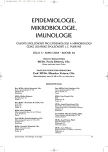Global eradication of poliomyelitis
Authors:
D. Slonim
Authors‘ workplace:
Předseda Národního komitétu certifikace eradikace poliomyelitidy v ČR
Published in:
Epidemiol. Mikrobiol. Imunol. 54, 2005, č. 3, s. 99-108
Overview
Global eradication of poliomyelitis launched and coordinated by the World Health Organization since 1988 is close to being achieved: the main objective is to discontinue the circulation of the wild, neurovirulent, endemic virus of poliomyelitis. Although this objective has been within the reach, there are two other risks, lower but existing and posing possible threat to the eradication, that need to be controlled: 1) wild polioviruses stored in laboratories should be destroyed or reliably contained and 2) emergence and epidemic role of neurovirulent polioviruses potentially derived from attenuated oral polio vaccine should be prevented. After all these global eradication objectives are met and three years relapse from its certification, under intensive and sensitive surveillance, it will be possible to consider whether or not to stop vaccination against poliomyelitis in the world. The global eradication of poliomyelitis is a complex issue that will require further efforts in the field of both the biomedical research and organizational, economic and political approaches. In the Czech Republic, poliomyelitis has been eradicated since 1960. The former Czechoslovakia was the first country in the world to achieve and to scientifically demonstrate nationwide eradication of poliomyelitis. The current post-eradication surveillance of poliomyelitis in the Czech Republic is managed by the Centre of Epidemiology and Microbiology of the National Institute of Public Health in cooperation with the Ministry of Health of the Czech Republic, WHO Regional Office for Europe in Copenhagen and National Certification Committee for Poliomyelitis Eradication.
Key words:
poliomyelitis – prevention and control – global eradication – situation in the Czech Republic
Labels
Hygiene and epidemiology Medical virology Clinical microbiologyArticle was published in
Epidemiology, Microbiology, Immunology

2005 Issue 3
Most read in this issue
- Flow cytometric differential gating strategy for evaluation of T-lymphocyte survival and proliferation in mixed lymphocyte reaction with dendritic cells
- Simultaneous vaccination against influenza and invasive pneumococcal disease in chronic dialysis patients
- Prevention of the development and importation of infections in members of the Army of the Czech Republic participating in foreign missions
- Serological survey and vaccination against viral hepatitis A in health care providers at the Clinic of Infectious Diseases in Ostrava
